Conductor launches SEO services marketplace for Searchlight users
Marketers can request analyses, content briefs and more directly through the interface.
Please visit Search Engine Land for the full article.
The steps to financial freedom are here. Visit our site if you want to be financially free and live a wealthy lifestyle
Marketers can request analyses, content briefs and more directly through the interface.
Please visit Search Engine Land for the full article.
LAS VEGAS — Delta Airlines may have just introduced the future of out-of-home advertising. At this year’s Consumer Electronics Show, Delta CEO Ed Bastian unveiled what the airline is calling Parallel Reality, a digital screen that gives airport travelers a custom, tailored message when they’re standing in front of it, including greetings, boarding times and…
Marketers can request analyses, content briefs and more directly through the interface.
Please visit Search Engine Land for the full article.
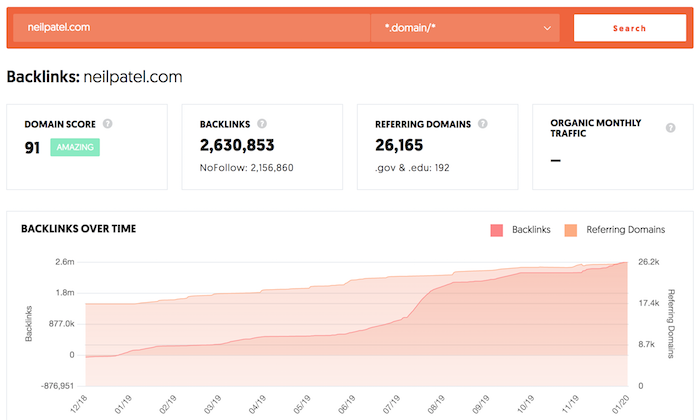
If you have ever left a comment on NeilPatel.com, you’ll notice that there is no URL field.
Why?
Well, a few years ago, blog commenting exploded. I was literally getting thousands of spam comments a day from people just leaving a comment for the purpose of link building instead of providing value to the community.
Sure, there are spam plugins like Akismet, but it doesn’t catch everything.
Now, most blog comments contain the nofollow attribute in which they tell Google not to follow the link or drive any “SEO value” to that URL.
But still, people still leave blog comments for the purpose of link building.
So, over the past 7 months, I’ve been running an interesting experiment to answer the age-old question…
Do backlinks from blog comments actually help rankings?
First off, for this experiment, we used “domain score,” which is similar to domain authority.
If you want to know your domain score, the backlinks report in Ubersuggest will tell you what it is.
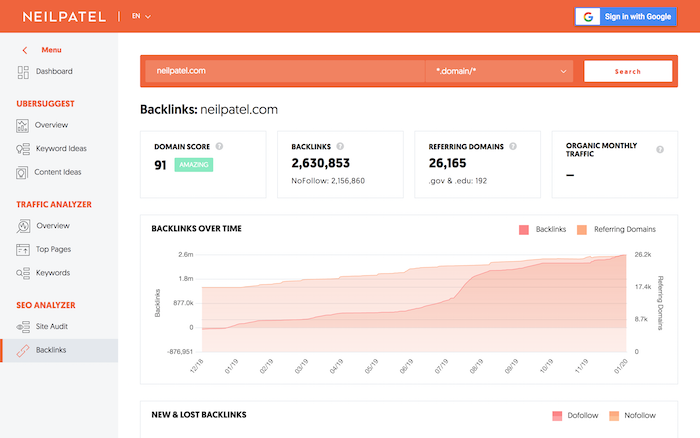
With this experiment, I sent out an email to a part of my list looking for participants and had 794 websites apply.
From there, I set the following criteria:
After eliminating the sites that didn’t meet the above criteria, I was left with 314 sites.
Of those 314 sites, many dropped off because they didn’t complete the required work on their part (which was to write a blog post), so I was left with 183 sites at the end that participated.
Similar to my previous link building experiment and my on-page SEO experiment, I had these websites write a 1,800 to 2,000-word blog post on whatever subject that was relevant to their site.
The websites had 2 weeks to publish their content and then after 30 days, I looked up their URL in Ubersuggest to see how many keywords each URL ranked for in the top 100 spots, top 50, spots, and top 10 spots.
As I have mentioned in the past, Ubersuggest has a big database of keywords. We are currently tracking 1,459,103,429 keywords.
Now, most of these keywords are barely searched but a decent amount of them get hundreds, if not thousands, of searches per month. A much smaller percentage of keywords generate hundreds of thousands or even millions of searches per month.
In other words, the majority of the keywords people are searching for are long-tail phrases.
We then spent a month building links and then waited another 3 months to see what happened to each site’s rankings.
But here’s the thing: We didn’t build the same type of links to all sites. Instead, we broke the 183 sites into 4 groups (roughly 46 sites per group).
Here were the groups:
Keep in mind with the link building for groups 2, 3 and 4,
there was no specific anchor text agenda. Because the links were built through
blog comments, it was too hard to control the anchor text as we didn’t want to
be spammy.
And each comment left on the blog contained at least 75
words as we wanted to ensure that each comment provided value and the core
purpose wasn’t just link building.
Alright, so let’s dive into the results.
Do you really need links to rank on Google? Well, the chart below says a lot…
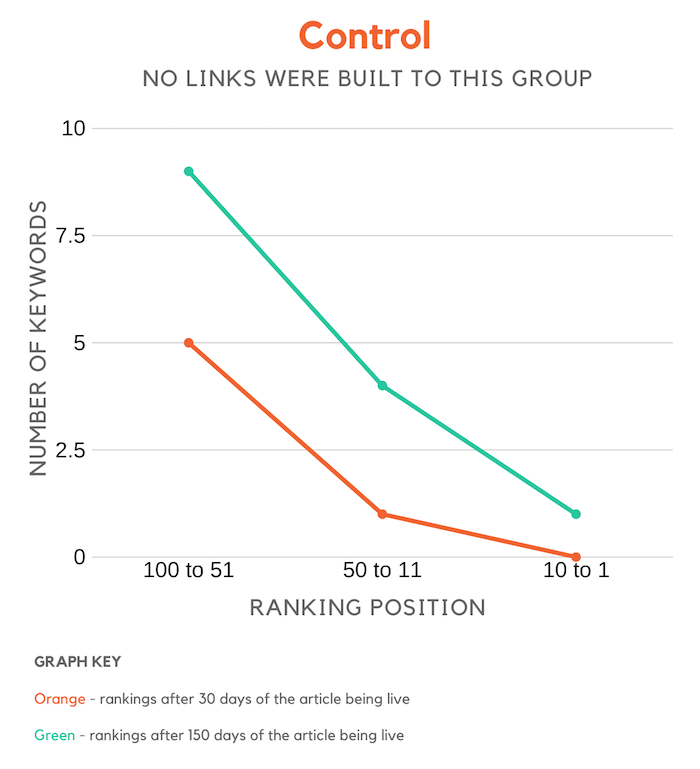
As you can see over time, you will naturally grow your search rankings even if you don’t build any links.
Of course, if your content is amazing and you do on-page SEO, you’ll rank higher, but still not growing your link count doesn’t mean you will rank for anything out there… instead, you will still rank for long-tail terms that aren’t too competitive.
Now the results from this group were interesting…
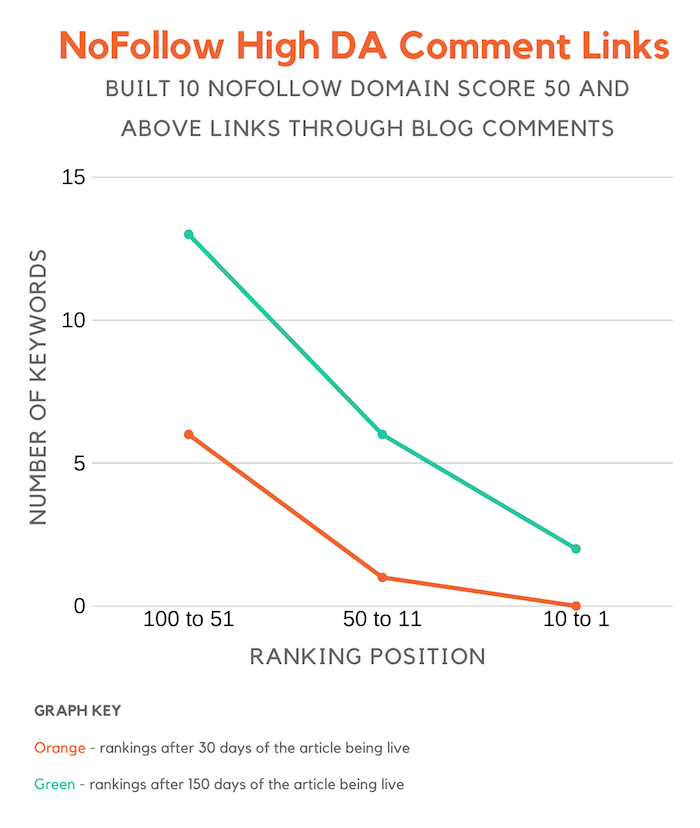
As you can see, the sites in this group had better results than the control group even though the links were nofollowed.
Keep in mind, though, that it could be many variables that caused this, such as the content quality may have been better.
Overall, the sites did perform better than the control group but not by a substantial amount.
Google is sophisticated, they are able to know if a link is from user-generated content (such as blog comments), so I assumed even though the links where dofollow they still wouldn’t have much (if any) impact.
But, shockingly, sites in this group had the largest gains.
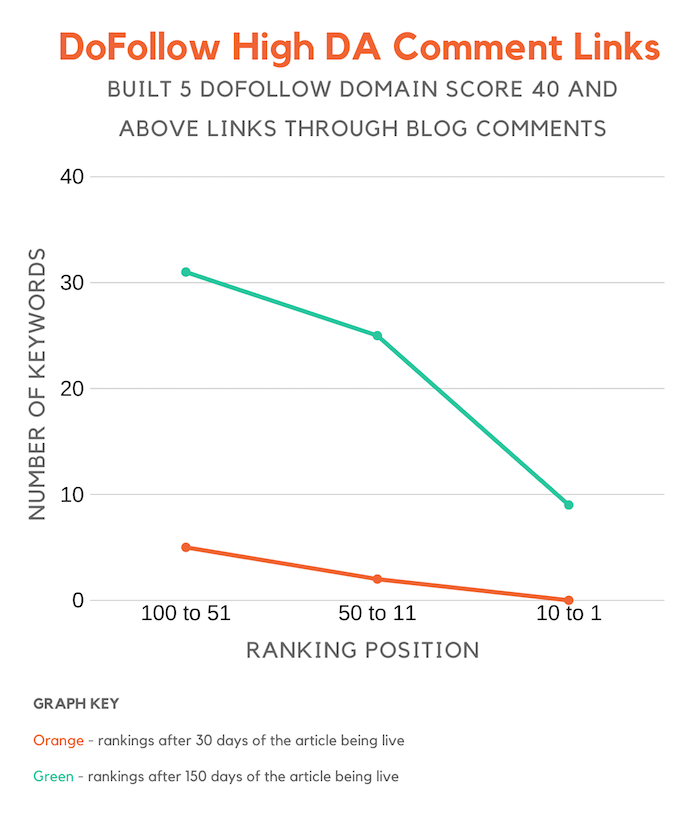
As you can see from the chart above, links from high authority sites, even if it is through user-generated content, help with rankings. They just have to be dofollow.
With this last group, we were able to build more dofollow links because we focused on sites with lower authority.
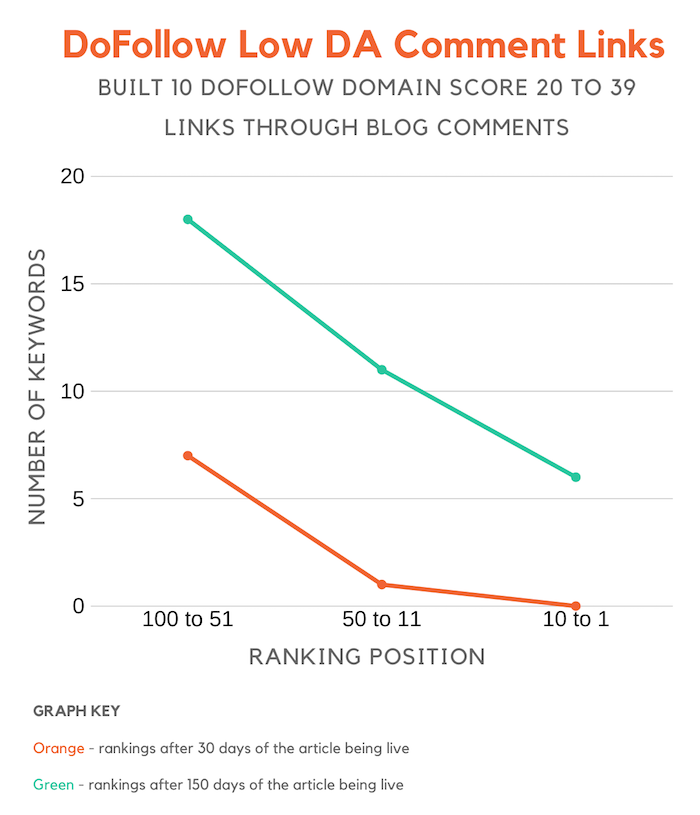
And as you can see from the chart above, it did help with rankings more than building nofollow links but it didn’t help nearly as much as getting links from blogs with higher domain scores.
We built 10 links instead of 5, but the quantity didn’t help
as much as having high domain score links. This group increased their rankings
by 337% versus 828% that group 3 experienced even though they had half the
links.
Again, we still saw gains, just not as large as the previous group.
Who would have thought that building links through blog
comments still helps?
Now, if you are going to use this tactic, you’ll want to focus on blogs that have dofollow comments.
If you aren’t sure how to find them, you can perform a Google search for the following:
When building links, focus on higher domain scores as it has a bigger impact on rankings.
In addition to that, you’ll only want to leave a comment if you can provide value. Don’t stress the anchor text, focus on the quality of your comment as you don’t want to be a spammer.
Posting spammy links will just cause your comment to be
removed.
Lastly, don’t just leave a valuable comment for the sake of generating a link. Make sure it is on relevant blogs as well. And if that means the blog doesn’t have as high of a domain score that’s fine because the data above shows that even low domain score links still help (just not as much).
So, have you thought about leaving more comments on other blogs? It’s a great way to get your brand out there, generate referral traffic, and boost your rankings.
The post Do High DA Backlinks From Blog Comments Help Rankings? appeared first on Neil Patel.

Every year, 80% of new year’s resolutions fail by the time February rolls around. Launching your email marketing strategy shouldn’t be one of them.
That’s why we created a simple, 7-day challenge to help you dominate email marketing in 2020.
By the end of it, you’ll have launched the most important parts of a successful email marketing strategy. And the best part? You only need 30 minutes or less each day to complete this challenge.
(Don’t have an email marketing platform? You’ll need one. Set up a FREE email marketing account in AWeber.)
This step is often overlooked. Many people use different email templates every time they send an email. Or, they never fully customize a template to match their brand.
But branding an email template and using it consistently are important. Your brand sets you apart from your competitors. It allows you to be unique and develop a personality for your business. It builds credibility and trust between you and your subscribers. Your subscribers can see your content and immediately tie it back to you.
Step 1: Choose your email template. Find an email template that works with your brand and your message. A plain template is often better than one already filled with colors and background images, because it’s easier to make it your own. Then, add your logo to the top or bottom of the email. (Inside AWeber, there are 8 NEW email templates you can easily customize to fit your branding. Choose the template format you’d like. Then drag and drop to add your images and build the layout you want.)
Step 2: Add your brand colors to your template. Don’t overdo it! Too many colors can be distracting. Try adding your brand colors in just a few places, like your call-to-action buttons, header image, or headlines.
For example, in the welcome email of AWeber’s FWD: Thinking newsletter, we incorporate our brand colors by using a header image with AWeber’s green and blue gradient and a call-to-action button with our brand’s shade of blue.
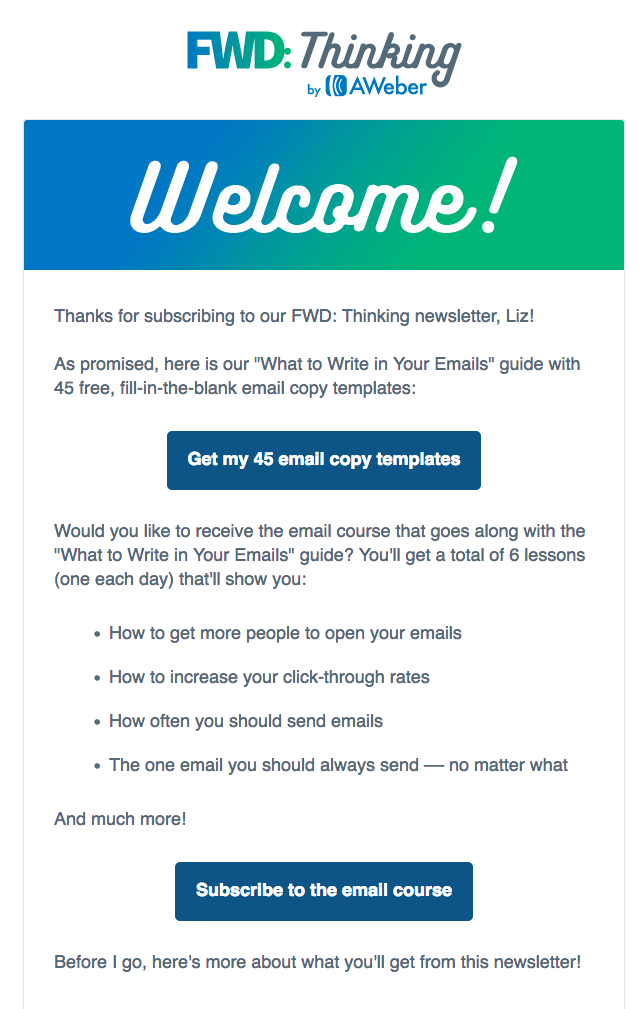
Homework: Watch this video on How to Design an Awesome Welcome Email.
To do: Choose an email template and add your logo and brand colors to it.
A confirmed opt-in message is an email you send people immediately after they fill out your sign up form. It asks them to verify they want to subscribe to your emails by clicking a link or button in the message.
Confirmation messages are optional but strongly recommended. They serve as proof that your subscribers definitely want to be on your list. So internet service providers (like Gmail and Yahoo!) may deliver more of your messages to the inbox when you use confirmation messages. Plus, it prevents subscribers from signing up using fake email addresses.
To make your subscribers more likely to confirm their subscription, you can follow these common best practices for confirmed opt-in emails:
Homework: Read Writing Confirmation and Welcome Emails People Love.
To do: Set up and customize the subject line and content of your confirmed opt-in email. (If you’re an AWeber customer, you can follow these directions to complete this step.)
Sign up forms allow your subscribers to easily join your email list. You can promote your form by adding it to your website and sharing a hosted sign up form with your audience. Hosted sign up forms allow you to share your form anywhere, even if you don’t have a website.
Homework: Read 9 Inspiring Sign Up Form Ideas to Grow Your Email List.
To do: Write your sign up form copy and build your form using ideas from the homework post you just read.
A welcome email is the first message subscribers receive after joining your list and confirming their subscription. And it gets a lot of attention — on average, open rates are 4 times higher and click-through rates are 5 times higher than other emails, according to marketing research company Experian. You can take advantage of this above average engagement by crafting an excellent welcome email.
Your welcome email should:
Once you draft your welcome email, take some time to personalize it! Personalization makes your subscribers feel you’re writing a message specifically to them. Something as simple as including your subscriber’s first name in the subject line or body of your welcome email can boost opens and clicks.
Homework: Read The One Email You Should Always Send and How Personalization Can Help You Connect with Subscribers.
To do: Write and build a welcome message for your subscribers using AWeber’s Drag and Drop Email Builder.
You wrote your welcome email. Your next step? Automate it. That way, your subscribers will receive it immediately after they sign up for your list.
Simply create an automated series for new subscribers in your email marketing platform. Here’s how:
Your email marketing system does the rest!
Homework: Read Email Automation 101: How to Use Automation.
To do: Create a welcome series using AWeber’s automation platform Campaigns and add in your welcome email. (Here are step-by-step instructions for setting up your own welcome series in AWeber.)
Your list is set up and your confirmation and welcome messages are ready to go. Now it’s time to put your hard work to the test and start to grow your list!
An easy first step is turning you social media followers into email subscribers. People who follow your brand on social media have already shown they want to hear from you. And there’s no better way for them to stay up to date on your latest content and sales than joining your email list.
Post a link to your hosted sign up form on Facebook, Twitter, and LinkedIn and ask your social followers to subscribe for exclusive updates.
Homework: Read 7 Expert Tricks to Grow Your Email List with Social Media.
To do: Add your sign up form to your Facebook profile and tweet out the hosted URL to your form.
Reach out to the people you already know, like colleagues, friends, or family members. Ask them if they want to sign up for your email list.
Let them know what content you are offering and explain the benefits they would receive if they sign up.
If they say no, maybe the content you’re offering just isn’t for them. But maybe they know someone it would be perfect for. You never know until you ask!
Homework: Read How To Get Your First 50 Email Subscribers in Less Than 30 Days. Use the fill-in-the-blank copy template in this post to easily reach out to people.
To do: Contact 5 people you know. Send them the hosted URL to your sign up form and ask if they’d like to join your email list or share it with someone they know.
Congrats! If you completed this 7-day challenge, you’re well on your way to launching a successful email marketing strategy.
Want more content like this? Subscribe to our FREE weekly email newsletter FWD: Thinking for email marketing tips from the pros.
Ready for your next challenge? Then try this: Create a lead magnet — a freebie you give subscribers when they sign up for your list. Lead magnets can increase the conversion rate of your sign up form.
For example, author and productivity expert Paula Rizzo offers a free List Making Starter Kit in return for signing up for her email newsletter, which she sends via AWeber.
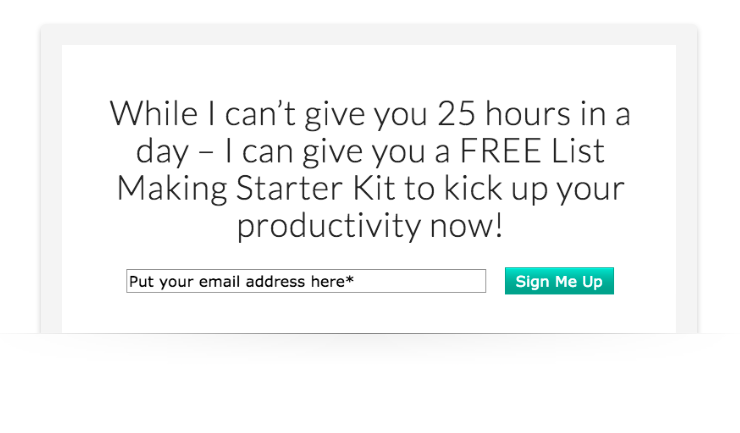
Homework: Read How to Create a Lead Magnet in Less Than a Day.
To do: Build a lead magnet, add a link to it in your welcome email, and mention it on your sign up form.
The post The 7-Day Challenge to Jumpstart Your Email Marketing in 2020 appeared first on Email Marketing Tips.
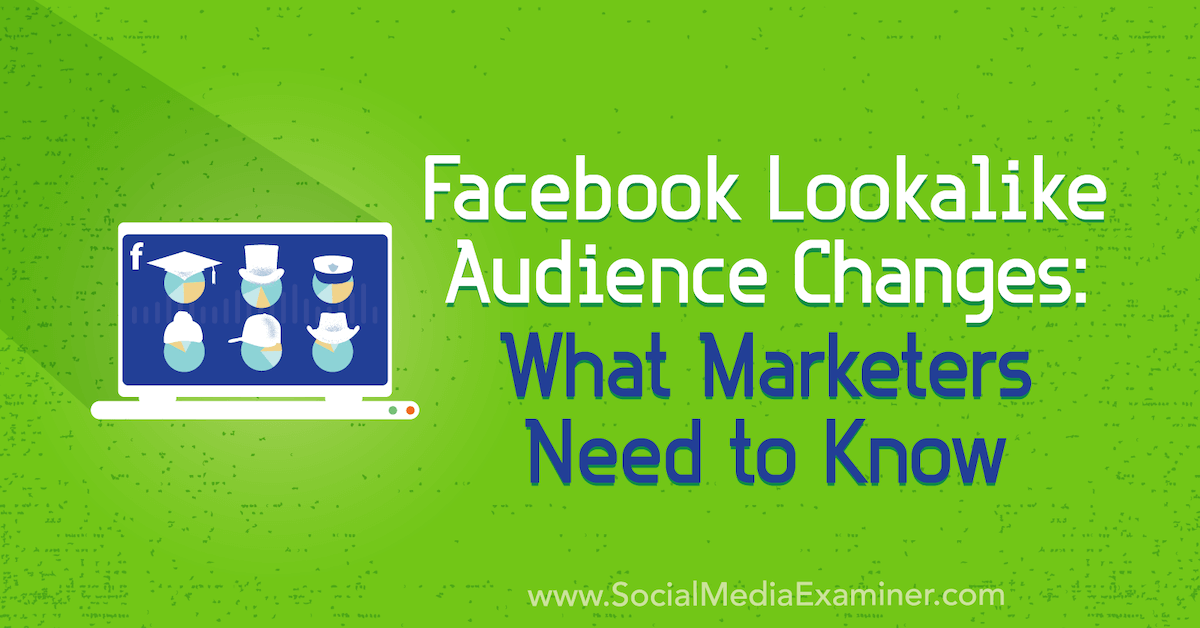
Do you use Facebook lookalike audiences? Are you aware of Facebook’s recent changes to lookalike audiences? In this article, you’ll learn what’s changed with Facebook lookalike audiences and discover four lookalikes to use with Facebook and Instagram ads. Changes to Facebook Lookalike Audience Creation Facebook recently introduced a big change in how you create lookalike […]
The post Facebook Lookalike Audience Changes: What Marketers Need to Know appeared first on Social Media Marketing | Social Media Examiner.
It estimates there are now 157 million of these devices in American homes.
Please visit Marketing Land for the full article.
Did you know:
Pinterest is such a key part of the buying journey for its users that over 90 percent of weekly active Pinners use Pinterest to make purchasing decisions.
Talk about buying power!
Not only are Pinterest users making purchase decisions on the platform, 83 percent say they are making purchases specifically based on the content they’ve seen from brands on Pinterest.
Pinterest is no longer simply a place to save ideas and build dream boards. Instead, Pinterest has turned into the world’s largest visual discovery platform.
And there are a lot of opportunities for brands.
We had a chance to chat with the team over at Pinterest about some of their best practices for brands looking to increase sales. We’re excited to share those lessons with you!
Here’s what we learned…
According to one survey, “47 percent of social media users saw Pinterest as the platform for discovering and shopping for products—more than three times higher than those who cited Facebook or Instagram.”
Seventy-seven percent of weekly Pinners have also discovered a new brand or product on Pinterest, and according to Pinterest, “people actually want to see content from brands while they’re on the platform–78 percent say it’s useful.”
Pinterest might not immediately come to mind as a platform to invest in for many brands, but it should.
Pinterest lives in a unique space on the internet where users are discovering content related to themselves and their aspirations rather than focusing on others, and this has turned it into a powerful platform for users to make purchasing decisions and discover new brands and products.
Clearly, Pinterest is not one to be ignored when it comes to your marketing strategy. Here’s how you can use the platform to drive sales.
There are some really simple ways that you can start leveraging Pinterest to reach new audiences and optimize your pins and profile for sales. Some of these tips might be easy to implement immediately while others might play into later strategies, let’s dive in!
A whopping 97 percent of top searches on Pinterest are unbranded, according to the Pinterest team. For brands, this presents an opportunity to stand out and gain brand recognition through the platform.
Pinterest recommends adding a small logo in one of the four corners of your pin, this can be done really easily in a tool like Canva. You can play around with the design, of course, and add your logo wherever it feels best. In this example from Quip, they went with top centered to fit with the rest of the text on their image.

As with most sites, mobile is extremely important on Pinterest. Eighty-five percent of Pinners are using the mobile app, so it’s important that your content appeals to them while they’re on their phones and appears properly in their feeds. If you’re linking back to your own content, it’s also important that the page that you’re sending users to is mobile friendly as well.
A tip from Pinterest here is to tailor your font size to phone rendering to make sure your fonts are legible on small screens and to design for a vertical aspect ratio. The ideal dimensions are 600 pixels x 900 pixels.

Have you ever clicked on a beautiful image on Pinterest only to be taken to a website that looks nothing like the pin? I have, and it left me really confused.
According to Pinterest, the best practice is to make sure your pins and your website have a similar look and feel, and that doing this pays off. In an analysis from Pinterest, they found that “Pins that went to landing pages with similar imagery had a 13 percent higher online sales lift.”
This example from Ettitude is really great. The pin they are sharing fits seamlessly in a lot of home decor and design tags on Pinterest.

And although their website uses different photos, it still has a similar feel to the pin.

A big element to social media marketing and campaigns is timing. When are people online and when are people talking about the things you want to talk about?
Luckily in the case of Pinterest, they release annual ‘Seasonal Insights,’ which helps take away some of the guesswork. A report that contains more than a dozen specific moments that take place throughout the year.

For example, their 2019 report shared that users start sharing holiday content in June all the way through December and that content related to the Summer starts getting pinned at the beginning of February.
They also have monthly trends reports. Here’s their latest for December 2019 trends on Pinterest, it shares specific trends like the search term ‘peach green tea’ is up 320 percent YoY!
These are great free resources that you can leverage to start timing seasonal campaigns around when people are starting to make specific seasonal purchasing decisions. I would never have thought that people start looking at holiday content in June but that’s super-specific information that can go a long way to help with timely campaigns.
One of the main ways for Pinterest to help generate sales is for the products you are selling to be easily available through Pinterest. Luckily, the platform makes this really easy for brands to set up and feature prominently on their profiles.
Every Business profile on Pinterest has the ability for users to create a “shop” tab.

The shop tab is just what it sounds like, a place where users can go to see all of the products your brand is selling. On the flip side, brands can leverage that tab to share pins that link directly to their sales pages for the specific product.

Pinterest makes this whole process quite easy, they even have a method for importing new products through Pinterest Catalogs. All you have to do is have your data source approved and then as you add new products to your website, they get automagically added to Pinterest as well.
We hope this guide helps you get started with or double down on your efforts with Pinterest. Let us know about your experience with Pinterest in the comments!
If you want even more Pinterest resources, the Pinterest team has created a free Pinterest Academy with tons of lessons in there.
“Old and clunky”
“So hard to use”
“This makes my head hurt”
“The product feels like it was built without any customers in mind”
Perhaps enterprise software providers should consider one of these phrases for the tagline of their next campaign. After all, they are direct quotes from users of their tools, left on review site G2.
The general consensus? Their software sucks. Really sucks.
How is this still the case in 2020? We live in an age of artificial intelligence, autonomous vehicles, and augmented reality. We are awash with incredibly advanced technology. But marketers still can’t find an enterprise software solution that doesn’t make their head hurt.
As far back as 2009, there were calls on enterprise software providers to pay more attention to the user-friendliness of their products, but like the proverbial ostrich, they put their head in the sand, rested on their laurels, and blindly trusted the lazy assumption that customers will forever accept pain as the price of power.
It’s one of the most extreme examples I’ve seen of Jim Collins’ ‘tyranny of the OR’ concept — the destructive tendency of some businesses to view all decisions as binary; a choice between A or B, but never both. Enterprise software providers have for years had the option to offer marketers tools that are both powerful and easy to use. But they haven’t. Rather, they’ve consistently fallen victim to the ‘tyranny of the OR’, pushing out endless features that are only powerful and never, ever easy to use.
Frankly, there’s no excuse for this. In recent years we’ve seen companies like Zoom, Shopify, and Slack refuse to compromise like other enterprise software providers. They’ve listened to customers, they’ve embraced advanced technologies, and they’ve completely transformed their industries by offering consumer-grade usability along with the deep power needed by rapidly growing businesses.
Y Combinator co-founder, Paul Graham, recently called out the vulnerability of enterprise software providers still stuck in the past, suggesting that they could someday “suddenly crumble.”

That day is coming sooner than you might think.
One third of B2B buyers say their customer experience expectations have increased. Even more say they’re ready to switch to a better solution. It’s time marketers were given an enterprise software solution they’ll actually enjoy using. One that combines power and ease-of-use. One that doesn’t suck.
So how did enterprise software providers lose their way? In short, they failed to adapt to the breadth of needs of the modern marketing team, which has undergone a major transformation over the past decade.
The explosion of marketing technology accelerated this transformation and significantly expanded the archetypes of marketers. New tools gave rise to new specialties and skill sets, which, when combined well, can make modern marketing teams greater than the sum of their parts. Enterprise software’s race to keep up was choppy at best, and it sacrificed usability as it added new features. Heading into the new decade, growing businesses have no choice but to demand more from their enterprise software. Customer expectations have risen to new heights, thanks to a wave of new B2C innovators that have disrupted entire industries by prioritizing user experience above all else.
Casper will ship a mattress to your door as if it was delivery pizza, Robinhood will let you trade stocks while you wait for the bus, and Netflix will give you — yes, you, personally — a carefully curated list of movie recommendations every time you sign in.
So why is it still so infuriatingly difficult to build a simple email campaign with most enterprise marketing tools?
Today’s providers, despite their big promises and wordy taglines, slow businesses down precisely at the moment they need to be moving faster. Over time, their software becomes overloaded with unnecessary forms, fields, workflows, and more, all of which get in the way of marketers trying to deliver the type of experience their customers expect.
For marketing operations leaders, this pain is multiplied. Whenever any marketer on their team is let down by their software — be they an email marketer struggling to segment a list, or a marketing analyst trying in vain to generate a report — the ops leader feels their pain. They are deep in the weeds with every tool, forced to wrestle daily with unwieldy systems that aren’t fit for purpose. And when those systems inevitably fail, they’re the ones on the front lines, trying to find a fix.
So why do so many marketers and operations leaders still put up with all of this complexity and clunkiness? Why don’t they simply switch to a different platform more suited to their needs?
Enterprise software providers have convinced their users that complex tools are in fact essential if they want to do complex things. They present confusion and clunkiness as an indicator of power, and ease-of-use as an indicator of technological limitations. It’s a myth. And it’s perpetuated by incumbents to dupe their customers into sticking with the same outdated, counter-intuitive platforms year after year.
For too long, enterprise software providers have gotten away with foisting tools built for the past on businesses trying to create the future.
What growing businesses deserve is enterprise software that’s built for the modern era — solutions that combine power and ease-of-use, and make it easy for them to put their most innovative ideas into practice, fast.
Speed has always mattered in marketing. The early adopters of email marketing saw open rates that marketers today can only dream of. The first Facebook advertisers got phenomenal bang for their buck. The quickest SEO strategists enjoyed years of first-page SERP rankings. To take advantage of marketing’s new frontiers and stay ahead of the competition, marketers need to be able to innovate quickly and execute efficiently.
And yet, slow strategy execution and insufficient digital capabilities remain top concerns of business leaders heading into the new decade. These two concerns are opposite sides of the same coin — without the right tools, strategy execution will never be fast enough. The enterprise platform you buy in 2020 should be able to evolve and adopt new technical approaches in such a way so that it is almost an entirely different platform by the time you hit 2022. It should combine innovation within its own feature set with extensibility found through integrations and an active app ecosystem. Slow-to-evolve technology leads to outdated marketing strategies. Maintaining seamless usability while steadily evolving will be the superpower of the next era of enterprise software.
With the wealth of powerful technology now available, growing businesses have an opportunity as never before to truly delight their customers, and gain a competitive advantage by doing so. But when it comes to choosing an enterprise software solution to fuel this growth, information asymmetry can get in the way of buyers picking the right provider for their team’s needs. The software evaluation process is notoriously noisy, as salespeople bamboozle buyers with bells, whistles, and add-ons they don’t need and will never use.
To cut through the noise and simplify the buying process, marketing and operations leaders should focus on five key ‘tests’. If the software doesn’t pass all five with flying colors, it isn’t right for any business that wants to grow better.
1. The Speed Test — enterprise software should significantly reduce the amount of time it takes marketers to complete essential tasks like building an email campaign and running a report. The less time it takes to complete standard tasks, the more time there is to focus on delighting customers.
2. The People Test — it’s a given that every type of marketer, from data analyst to creative designer, should be able to work with their company’s enterprise software, but they should also each have an equally positive experience with it. If even one marketing function isn’t set up for success with its software, it will negatively impact all aspects of the team’s work.
3. The Customer Test — enterprise software should make marketers’ jobs easier, and should therefore be loved by its users. If its reviews on sites like G2.com and Capterra aren’t glowing, it’s a sign that there could be usability or functionality issues, which may only show up after a contract is signed.
4. The Window Test — if completing standard marketing tasks requires multiple windows and tabs open at the same time, it’s an indicator that the software is not built with user-friendliness in mind. The more tabs open, the greater the likelihood of oversights, errors, and ultimately, unhappy customers.
5. The Extensibility Test — enterprise software should grow with a business. Full stop. As a team’s needs evolve, it should be easy to integrate new tools directly into its flow of work, and to sync data bidirectionally. Systems that lack this ability can stifle innovation and create stagnation. Customers’ expectations are always evolving and marketers need to be able to adopt new tools that help them offer ongoing delightful experiences.
It’s 2020. Businesses should not have to compromise on any of these essential requirements of a modern enterprise marketing solution. Emailing should be enjoyable. Reporting should be reliable. Segmentation should be straightforward. A/B testing should not test your patience. This is what enterprise software should look like. And with the newly revamped Marketing Hub Enterprise, it does.
At the beginning of this post, I shared quotes from G2 reviews of enterprise marketing software. And I will leave you with the words of another exasperated enterprise software user whose advice to marketers is to simply, “Save your time and use HubSpot.”
HubSpot’s Marketing Hub Enterprise now includes new revenue attribution reporting, partitioning, AI-powered A/B testing, and ABM features, as well as increased limits on lists and workflows.
Marketing Hub Enterprise: Always Easy. Now deeply powerful.
![]()
If distraction prevents you from reaching the goals you truly want to achieve, this episode is for you. I spoke with Nir Eyal, international best-selling author of a new book called Indistractable: How to Control Your Attention and Choose Your Life. We talked about the simple yet powerful changes you can make to control your mind and use your time more effectively. You’ll also find lots of bonus content on the blog.
If you like what you hear, write a review, subscribe on Apple Podcasts and, one more thing, be sure to sign up for my Quick Tips from Marketing Mentor.